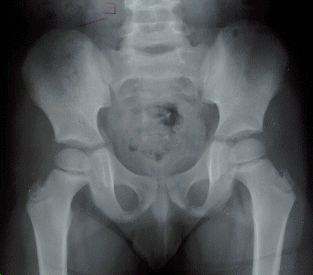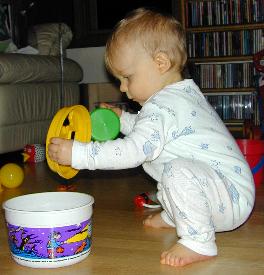Why Adults Can’t Squat Like Babies and Should Stop Trying To
For some reason, at one point in time or another, someone suggested that since and toddlers can squat with relatively admirable mechanics that this is somehow a trait that has been “trained out” of most people. From there it became a de facto argument as to why we should try to squat “ass to grass” all the time. Sure, having a few young nephews and nieces running around, I’ve watched in awe at their relative ease at dropping into a hamstrings-on-calves squat that produces next to no spinal flexion, a neutral neck position, and relative ease at sitting there for what would seem like as much time as necessary to figure out the mechanics of the Play Doh machine or the colouring book, or picking up that stuff that looks like food but isn’t even close to edible.
But the funny thing is – and I can’t believe I’m the one who has to point this out – ADULTS AREN’T BABIES. We’ve gone through size and morphological changes since we were running around in Huggies, and we can’t really go back. For starters, our bones are hopefully somewhat different lengths and thicknesses compared to when we were watching the generationally-appropriate equivalent of Toopi and Binoo. Our muscles have developed more tone, which explains why we fall over much less and don’t run in a stomping and squealing manner.
Let’s break down some of the reasons why, structurally speaking, we can’t squat like babies.
First, head size plays a big role. a 2 year old has already had their head reach 3/4 of it’s full growth, even though physically they’re only at relatively 20-30% of their final body size in terms of weight and maybe 40-50% of their size in height. This means when they squat their head is going to provide more weight anteriorly to their centre of mass than an adult, who is going to have much more mass around their hips and a posterior shift in their centre of mass. This makes squatting to depth easier for a baby as they can sit back into the movement a lot easier.
One way adults could simulate this baby head size thing is to take a weighted football helmet that adds about 10% of their total body weight to their head, and then squat. For me this would be the equivalent of adding a 25 pound plate to my cranium in order to dip it low. This is one of the reasons why it’s easier to squat deeper when you put your arms out in front of you, as it shifts your centre of mass forward making it easier to sit back into the movement without falling over, and also why front squats and goblet squats are magic for producing depth.
Leg length also plays a massive role in being able to squat. An infant leg is an average of 19 cm from the sub ischial position to calcaneus, whereas a full grown adult averages 81 cm in men and 74.5 cm in women. As the individual ages, the relative contribution of the legs to their total height increases. Where as a new born has 70% of its total height coming from their sitting height, a teenager contributes only 52% of their standing height from their sitting height, meaning their leg length went from being only 30% of their total height to 48% of their total height.
This alteration in anthropometric percentages means it’s much harder for a long-legged adult to squat. Powerlifters have known this for a long time, noting that those lifters who have a long femur relative to their total height would have a harder time squatting compared to shorter limbed lifters.
The infant pelvis is also 3 non-fused bones connected through cartillagenous growth plates that later fuse at the end of puberty. The 3 bones are the ilium, ischium, and pubis, and when they are fused they limit movement to only the SI joint and some small movement through the pubic symphesis. If we want to squat like babies, it’s really simple. We just have to cut our femurs down by half and break the pelvis into 3 parts per side again. Shouldn’t be too much trouble.
Finally, infants tend to have a much larger acetabular width to depth ratio than adults. This greater adult depth will allow adults to bear more weight successfully while in upright ambulation, but will limit squat depth. The yin and yang of this is important, because most adults will choose the ability to walk and stand versus hit a deep squat all day long.
 So to summarize the main points:
So to summarize the main points:
- Infant’s heads are twice the size of an adults relative to their standing height
- Infants torsos account for 50% more of their total height than adults.
- Infants femurs are 50% shorter than an adults matched to their height.
- Infants have a greater width of their acetabulum whereas adults have a deeper acetabulum.
Adults don’t have the same proportions, levers, or mechanics to squat as an infant. The closest approximation one could get to the proportions of an infant is someone who has dwarfism. The typical physical proportions for drawfism invole an average torso size, shorter limb lengths, and a larger than proportionate head. These characteristics are similar to an infant, and can make it much easier to squat compared to others who have longer limbs. The most known example of this is Peter Dinklage, who no doubt can drop it like it’s hot, and also act the hell out of anyone in modern times.
One awesome example of this is a competitive powerlifter, Andrzej Stanaszek, who also has dwarfism.
[embedplusvideo height=”367″ width=”600″ editlink=”http://bit.ly/1zEI5Dj” standard=”http://www.youtube.com/v/X57aLTTEX_w?fs=1″ vars=”ytid=X57aLTTEX_w&width=600&height=367&start=&stop=&rs=w&hd=0&autoplay=0&react=1&chapters=¬es=” id=”ep3495″ /]
The depth of the squat was to parallel, and only a couple inches, but he nailed it for a nearly 5 times bodyweight squat in competition. Not too shabby.
At the end of the day, adults are not children, nor do we exhibit the need to squat in the same manner, unless we haven’t seen growth since we were 5. Everyone has their own squat based on their specific structure, genetics, and abilities. This doesn’t mean you should not focus on using the maximum range of motion you have available, but rather that you realize that you will have an end point to your range of motion that is different from others. Train hard with what you have, and don’t try to fit your round peg into a babies square hole.



44 Responses to Why Adults Can’t Squat Like Babies and Should Stop Trying To